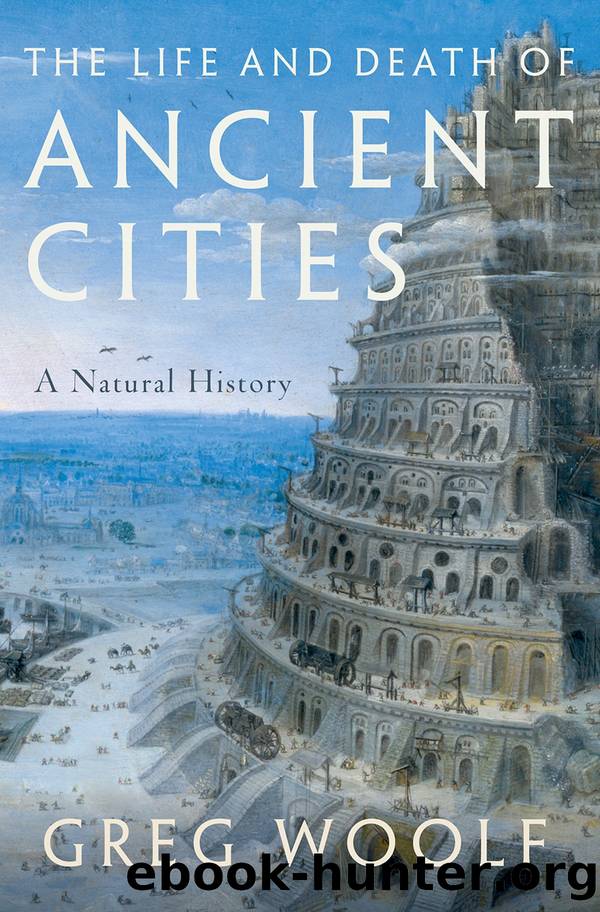The Life and Death of Ancient Cities by Greg Woolf

Author:Greg Woolf
Language: eng
Format: epub, azw3
Publisher: Oxford University Press
Published: 2020-07-15T00:00:00+00:00
PART
III
Imperial Urbanisms
13
City and Empire
Imagine the Persian Emperor Darius surveying the Mediterranean world on the eve of his failed invasion of Greece, the Marathon campaign of 490 b.c.e. Behind him the Achaemenid Persian Empire stretched back eastward over Anatolia and Mesopotamia onto the Iranian plateau and beyond to Afghanistan, and south as far as the Hindu Kush and the borders of India. Looking westward, the shores and islands of the middle sea were divided among hundreds of cities and tiny tribes. It was not just the Aegean world that lived, fought, and died at the small scale. If he could have seen beyond to the valleys of the Balkans or to Italy on the other side of the Adriatic, it would have been the same. All around the Alps and the Atlas, along the Mediterranean coasts of France and Spain, on Sicily and the other islands, the Iron Age Mediterranean was a mosaic of tiny territories. Tiny cities—Greek, Phoenician, and Etruscan among them—lay along the shores. Behind them in the valleys and high plateaux were territories of villages, hill forts, and loose tribal federations. Darius’ empire measured nearly 4,000 kilometres west to east. Attica on its longest axis was less than a 100 kilometres long, and it was a giant among city-states. The western frontier of Persian power marked the boundary between two worlds.
During the next half-millennium, that boundary collapsed. The political map of the Mediterranean was transformed as bigger and bigger political units appeared. These larger units were at first quite various. There were alliances, some relatively stable like the Peloponnesian League created by Sparta, some quite short-lived like the Greek alliance against the Persians. There were federal states like that of the Aetolians within which cities grew up, and leagues of cities like that in Boeotia or later Achaea, with formal constitutions. Powerful cities like Athens, Rome, Sparta, and Syracuse dominated their neighbours in informal ways we sometimes call hegemonies. Sometimes these evolved over time into micro-empires, sometimes they fell apart. There were monarchies too, and groups of chiefdoms connected by dynastic marriages, as happened in the north Balkans. There were a few hybrid states like those of the northern Black Sea or the south of France, where cities and chiefdoms were closely connected. The city-state and the kingdom were the two fundamental building blocks in Mediterranean politics. Imperial projects arose from both. Most were short-lived, because the geographical pressures towards fragmentation were very powerful and because local identities and loyalties were so strong. Yet by the turn of the millennia the Mediterranean Basin had become a single political entity, one vast system of domination in which one monarch, the Roman emperor, ruled over and through two thousand cities and a cluster of lesser kings. This chapter takes the long view, from the empire of Darius to the empire of Augustus, and seeks to understand how the extreme fragmentation of the Mediterranean world was overcome.
Download
The Life and Death of Ancient Cities by Greg Woolf.azw3
This site does not store any files on its server. We only index and link to content provided by other sites. Please contact the content providers to delete copyright contents if any and email us, we'll remove relevant links or contents immediately.
| Africa | Americas |
| Arctic & Antarctica | Asia |
| Australia & Oceania | Europe |
| Middle East | Russia |
| United States | World |
| Ancient Civilizations | Military |
| Historical Study & Educational Resources |
Alexander the Great by Robin Lane Fox(1179)
Mythos (2019 Re-Issue) by Stephen Fry(1171)
Antigone Rising: The Subversive Power of the Ancient Myths by Helen Morales(947)
On Sparta (Penguin Classics) by Plutarch(927)
The Classical World: An Epic History From Homer to Hadrian by Robin Lane Fox(887)
The Last Days of Socrates by Plato & Christopher Rowe & Plato(885)
Persian Fire by Tom Holland(826)
Cicero by Anthony Everitt(779)
The Athenian Constitution (Classics) by Aristotle(772)
The Greek World(699)
Antigone Rising by Helen Morales(658)
The Eudemian Ethics (Oxford World's Classics) by Kenny Anthony(647)
The Riddle of the Labyrinth(629)
The Story of the Greeks (Yesterday's Classics) by Guerber H. A(620)
Lords of the Sea: The Epic Story of the Athenian Navy and the Birth of Democracy by John R. Hale(617)
Guide to Greece by Pausanias(608)
The End of the Bronze Age by Robert Drews;(592)
The Homeric Hymns (Penguin Classics) by Homer(576)
Astrology and Religion Among the Greeks and Romans by Cumont Franz(572)
